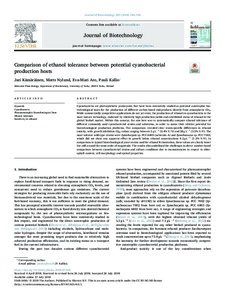Comparison of ethanol tolerance between potential cyanobacterial production hosts
Jari Kämäräinen; Matts Nylund; Eva-Mari Aro; Pauli Kallio
Comparison of ethanol tolerance between potential cyanobacterial production hosts
Jari Kämäräinen
Matts Nylund
Eva-Mari Aro
Pauli Kallio
ELSEVIER SCIENCE BV
Julkaisun pysyvä osoite on:
https://urn.fi/URN:NBN:fi-fe2021042719711
https://urn.fi/URN:NBN:fi-fe2021042719711
Tiivistelmä
Cyanobacteria are photosynthetic prokaryotes that have been extensively studied as potential autotrophic biotechnological hosts for the production of different carbon-based end-products directly from atmospheric CO2. While commercially competitive applications do not yet exist, the production of ethanol in cyanobacteria is the most mature technology, endorsed by relatively high production yields and established status of ethanol in the global biofuel market. Within this concept, the aim here was to systematically compare ethanol tolerance of different commonly used cyanobacterial strains and substrains, in order to assess their relative potential for biotechnological production platforms. The comparison revealed clear strain-specific differences in ethanol toxicity, with growth inhibition GI(50 )values ranging between 3 gL(-1) (0.4% V/V) and 28 g L-1 (3.5% V/V). The most tolerant wild-type strains were Synechocystis sp. PCC 6803 (substrain A) and Synechococcus sp. PCC 7002, which did not show any apparent effect in growth below ethanol concentrations 9.2 gL(-1 )(1.2% V/V). In comparison to typical biotechnological yeast strains used for ethanol fermentation, these values are clearly lower but still around the same order of magnitude. The results also underlined the challenges in direct number-based comparison between cyanobacterial strains and culture conditions due to inconsistencies in respect to chlorophyll content, cell morphology and optical properties.
Kokoelmat
- Rinnakkaistallenteet [27094]
